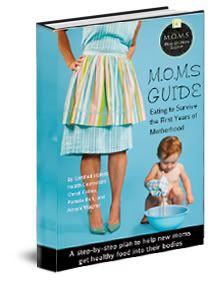Healthy Eating for Motherhood
January 4, 2009
I recently did an email Interview with Christi Collins, holistic health counselor and co-author of the “Eating to Survive Motherhood” eBook.
Christi is very, very pregnant and ready to pop at any moment – so she asked me to let you know that she may not be available via email for a little while.
Christi shared her wisdom on Eating for Motherhood with us. I think you’ll enjoy this information as much as I did. A lot of it sounded very familiar to my own experiences, especially when she talked about thrush, cravings, and low blood sugar.
Enjoy ![]()
Q: Christi, your area of expertise is helping moms eat a healthful diet during the early postpartum years.
I keenly remember how difficult it was to get a healthy meal on the dinner table each night while juggling a nursing or fussy infant, much less eating healthy all day!
What are some of your tips for moms who are feeling overwhelmed by trying to eat healthy?
by trying to eat healthy?
A: Carrie, a few years ago when I was running my health coaching practice, I used to consider myself an expert at helping busy women eat a healthy diet.
Once I became a new mom, I realized it was a whole new ballgame!
I became a beginner all over again, and had to learn how to change my eating strategy in order to survive life with a babe.
I feel so badly for all the new moms I used to coach before becoming a new mom myself.
I could never understand why it was so hard for my mom clients to make and eat a meal while taking care of a new baby.
My goodness, my expectations for them were totally unrealistic! Once I had my own baby, I quickly acquired a newfound respect for my former mom clients… and I sure did learn my lesson!
I vividly remember the ravenous hunger I had when I was a new mom. My mom came to take care of me the first week after my son was born, and she teased me about the fact that I was stuffing my face with food in every picture and video that she took.
When my son was 3 weeks old, my friend, Fee (who’s also a holistic health counselor) came to spend a week with me from France. After a few days of cooking for me, she said, “I don’t get it. I’m cooking your meals. I’m putting them in front of you. You’re STILL not getting around to eating half of the food… all you’re doing is breastfeeding!”
She was right. Even with someone cooking for me full-time, I still had trouble getting the good food in me. I couldn’t understand why eating well was so dang difficult… how could one baby turn my world upside down?
I simply had no idea that the task of preparing and eating food could be so difficult with an infant around.
Now that my son is 2 1/2, eating well is still a challenge!
In preparation for my second child, I knew I had to approach my meals differently. I knew I needed quick, simply reminders of foods, recipes, and cooking strategies that would help me get good food in my body.
For me, the secret to eating healthy when you’re a mom comes down to three things:
1. Plan Ahead
If I don’t think about my meals until I’m standing in front of the fridge at mealtime, NO amount of creativity or willpower will help me come up with a meal plan at that time.
The uncut veggies in my fridge and un-thawed meat in my freezer love to mock me. I simply stand in front of the fridge with a blank mind.
I’ve learned that I need to have a list of potential meals around to jog my memory at mealtime.
On the side of my fridge, you’ll find a little post-it note with a few breakfast, lunch, dinner, and snack suggestions for myself. This helps me remember what the heck I originally planned to do with the food that I bought at the store. These are not gourmet meals. They’re staples like “Stir Fry, Lentils and Rice, and Homemade Pizza.”
My favorite plan-ahead meal is my Breakfast Muesli (I included this recipe in the “Eating to Survive Motherhood” eBook, since it’s so tasty!). It’s an oatmeal mixture that I throw together in about 15 seconds at night. I then put it in the fridge, and it’s ready to eat in the morning… no cooking required. It saves me time and energy in the morning, and it’s so easy to make that I can ask my husband to do it for me at night if I’m too tired.
I’ve learned the hard way that I have to plan ahead… even if it’s just a few meals and snacks per week.
Otherwise, I will head for the fastest, easiest food available… which unfortunately, tends to be the candy corn or chocolate bar in my cupboard!
2. Cut corners and lower your expectations
New motherhood is not the time to chop all of your produce by hand.
Buy pre-cut veggies and fruit, for goodness’ sake! I know it’s more expensive, but you’re not going out as much as you used to, so you can use that extra money to treat yourself to pre-cut produce. Use frozen fruit for smoothies (they won’t spoil!). Forgo homemade soup for canned or pre-made soup. In time, you will get back to cooking more… but at the beginning (or whenever you hit a rough patch) it’s important to let others do the work for you.
New motherhood is also not the time to try out lots of new recipes.
Stick with your top 5 tried ‘n’ true favorites. The grocery shopping list that we included in the “Eating to Survive Motherhood” eBook is made up of all the ingredients that Pam, Amara, and I use when we cook for ourselves. Rather than make up a new grocery list every time I go to the store, I simply take out a fresh copy of the shopping list from the eBook and mark off the items that need replenishing. It’s much easier that way!
I believe it’s very important to be extra kind to yourself when you’re a mom. There are so many opportunities to blame yourself during motherhood, so why not be gentle with yourself when it comes to your food?
When I was going through intense PPD with my son, I was totally overwhelmed.
The only thing I could manage was to start with “one thing” and move on from there.
My initial “one thing” was to increase my water intake.
I focused on that for about a week, using reminder notes and filled water bottles all over my house to get on track with my hydration. Once I wasn’t overwhelmed by drinking water, I added in “eat a healthy smoothie or bowl of Oatmeal Muesli every morning” to my goals.
Once I got a healthy breakfast under my belt, I moved on to something else.
I think it’s unrealistic for new moms to expect to eat healthy all day long… but if we can focus on getting 1 or 2 good meals into our bodies, that’s a great start. Things will improve as we get more sleep and establish more of a routine.
3. Use all the tools you’ve got!
We list a bunch of cooking tools in the “Eating to Survive Motherhood” eBook. Personally, my favorite tools are my Vita-Mix blender and my rice cooker. 
Even if the day goes downhill quickly, I can always throw some fruit, flaxseeds, hemp milk, raw nuts, kale, and frozen blueberries into the blender for a quick, healthy and filling meal. My toddler loves these smoothies too, so I can feed both of us at once.
I firmly believe that my rice cooker is the only reason I’ve eaten non-burnt grains since my son was born. I simply can’t remember to turn down the grains if I cook them on the stove, but the rice cooker does all the hard work for me. It keeps the rice, oatmeal, quinoa, or millet hot… so I don’t have to waste more pots and pans (and washing time) to warm my meal. And if I remember (which is only about 1/10 of the time) I can throw some veggies in the steamer pot to steam while the grains are cooking. But I wasn’t able to do that until my son was at least a year old!
Q: What are some of the problems new moms will experience if they don’t pay careful attention to their diets?
One of the challenges that I had personal experience with was Postpartum Depression. After my son was born, I wasn’t getting enough food into my body, so my blood sugar was low. This led me to crave sugar, which led me to crave wine… and that didn’t help my depression much at all.
When I wasn’t eating well, I felt lethargic. Once I started eating better, I found enough energy to start the healing process from PPD.
Postpartum Depression is exacerbated by sugar, processed foods, and alcohol.
It’s very important for any new moms who struggle with mood swings and depression to eat well… and eat small meals regularly throughout the day. This will keep their blood sugar and hormones stable, and help them balance their mood. There are certain foods that can help moms heal from depression, and we list these in the eBook.
A mom’s diet also has a direct impact on breastfeeding. If a mom isn’t getting enough calories (or isn’t getting enough of the right kinds of foods) her milk supply can decrease.
In the “Eating to Survive Motherhood” eBook, we included a list of foods that boost milk production, such as oatmeal and Mothers’ Milk tea.
If the mom or the baby has thrush, then the mom needs to pay close attention to her diet and make sure she’s not consuming a lot of sugar, processed foods like bagels and cookies, alcohol, or lots of grains and fruit. These foods will only feed the thrush.
There are so many ways that diet affects new moms… but if I had to pick one last area that affected me personally after my son was born, it was my digestion.
I’ve always had a sensitive digestive tract, but my C-section recovery completely threw my bowels for a loop. I had to really focus on eating foods that would get rid of my constipation. I ate a ton of prunes and ground flaxseeds.
I even started eating sauerkraut for the first time – it’s now one of my favorite foods! I also had to remember to take time each morning to sit in the bathroom and let my bowels do their work in peace. This took some retraining, since I had gotten in the habit of not taking time for myself after Evan was born.
Q: Your eBook talks about some of the crutches we moms tend to use to boost our energy. What are some healthier alternatives to these?
The most common food crutches that new moms use are sugar and caffeine. And why not? We’re completely exhausted! It’s no wonder our body turns to those foods for a quick pick me up. The problem is that sugar and caffeine aren’t real fixes. In fact, they make energy problems worse by sending our blood sugar on a roller coaste r ride.
r ride.
New moms need all the energy they can get, but sugar and caffeine aren’t good answers to the energy problem!
Energy levels are often low because new moms don’t get enough water throughout the day (particularly nursing moms). Increasing your water intake is an effective way to boost your energy levels quickly.
A quick protein-based snack will often do the trick.
Protein was the hardest thing for me to get into my diet as a new mom. The quick foods I will rely on this next time around are hardboiled eggs, pre-cooked edamame, hummus, raw nuts, and frozen shrimp. As you’ll notice, all of these foods can be eaten with one hand!
Often, low iron stores after birth can deplete energy levels. It’s very important for new moms to eat iron-rich foods like sweet potatoes, dried apricots, molasses, and (if they’re not vegan or vegetarian) animal protein.
My favorite energy boosting snack – Power Balls – is included in the recipes section of the “Eating to Survive Motherhood.” These scrumptious little balls stick with me for hours, and my toddler loves them. Best of all, they can be eaten in a car… and eaten with one hand (which is oh-so-important when you’re breastfeeding all the time!). I throw all my favorite power foods into these balls – molasses, flaxseeds, kale, etc..
Christi this information is fantastic. Thank you SO much for taking the time to share this important info with us. (I’ll be back shortly with a review of Christi’s book. Stay tuned!)
![]() photo credit: Jack Mora
photo credit: Jack Mora
![]() photo credit: tiffanywashko
photo credit: tiffanywashko
More Posts By Carrie:
- Quick and Healthy One Pot Meals
- Natural Moms Podcast #116
- Grocery Shopping and Dinner Planning Printables
Comments
Got something to say?












